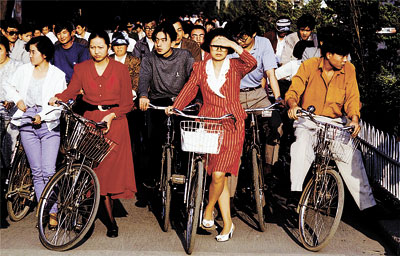|
IT was a long, dark, snowy winter’s night in 1989. Two streetlights swayed in the darkness. Yann Layma was behind the wheel of a jeep in the remote mountains of the southwest province of Guizhou. Suddenly, the car ground to a halt and Layma, along with his two companions, had no choice but to walk over 10 km to reach the ethnic minority community he was going to photograph.
“We did not have enough clothes, so we put newspapers inside our thin jackets to keep warm,” Layma said in pidgin Chinese.
However, they fell through an ice hole. “We were so cold and on the edge of death,” Layma said. “But the villagers dared not help us because China was at the very early beginning of opening up,” Layma explained. Foreigners, especially in underdeveloped Guizhou, were still a rare sight.
“In their eyes, I was a ghost,” Layma said. Finally, a girl and her father offered them help. They gave Layma alcohol to warm his body and offered him a bed to rest in.
This is just one of Layma’s stories from the more than 30 years he spent in China, during which he walked across most of the country.
In 1984, Layma was commissioned to take photographs for then French president Francois Mitterand in the Elysee Palace, Paris, France, for one year. During this time, Mitterand encouraged Layma to read Confucius, the famous ideologist and philosopher.
Through his readings, Layma fell in love with the far-east country.
The inspiration for moving to China came to him in a dream: “I dreamed of taking photographs in China.”
It was his psychiatrist who suggested he follow his dream and gave him a camera.
After studying Chinese in Paris for one year, he went to Taiwan, where he was given the name “Yan Lei” (thunder in hell). He moved to Beijing in 1985.

“When I first arrived, there was no expressway and the roads were full of bicycles.”
“The people wore gray and there was not much commercial industry,” he said. “But it was pure like water.”
“It is difficult for young people today to understand what Beijing was like back then because China has seen remarkable development over the past few decades,” Layma said.
In his words, China’s beauty not only exists in colorful ethnic minority regions and grand landscapes, but can also be found in common daily life.
Some of his favorite images portray old women. “They all had bound feet, a practice that crippled women both physically and spiritually in feudal society,” Layma explained. “These images are snapshots of real life that reflect real history.”
His photos range from an underground disco party to the operation of China’s first stock exchange.
Even though his works seldom touch on politics, Layma said he had been interrogated by police when holding a camera in the street in the 1980s. “They would ask me what I was doing and what I was photographing,” Layma said. “But I had not broken any rules.”
In the 1980s, personal relationships with foreigners were rare in China. “Anyone who came into contact with me had to report and register with the authorities,” Layma told.
Layma can now walk and ride without any special attention from others across the country.
“China has truly progressed, which marks its more inclusiveness,” Layma said. However, he witnessed traditional cultures fading during the country’s rising. “I returned to the village in Guizhou Province in 1998,” he said. “But I could not find conventional lifestyles such as diversified minority costumes.”
To preserve his memory of China’s 1980s to 1990s, he has published five photo collection books, including newly launched “Yesterday’s China.”
The selected photos in the book were captured from 1985 to 1995. “People prefer to leaf through the pictures of juvenile and youth periods,” the book’s publisher Na Rising noted, “since they carry our abundant memory of past times.”
Layma’s story with China is not over. In 2005, Layma was granted the Chevalier de la Legion d’Honneur for his great contributions to China-France culture exchange.
Over three years ago, he met his wife online. And now, they split their time between Beijing and Tours, France, with their 10-month child. Layma spends a lot of his time selling the works of other Chinese photographers abroad.
Some people, in China and France, find his transition from artist to art dealer odd. “I just hope to live better even though I am turning into a businessman,” he responded. (Xinhua)
|

